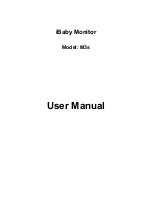
3
Electromagnetic interference
The device contains sensitive electronic components. Avoid strong electrical
or electromagnetic fields in the direct vicinity of the device (e.g. mobile
telephones, microwave ovens. Electrical interference can lead to temporary
impairment of the measuring accuracy).
2.
Important information on the subject of blood-pressure and its
measurement
2.1. How does high/low blood-pressure arise?
Your blood pressure level is determined in the circulatory center of your brain.
Your nervous system allows your body to adapt or alter blood pressure in
response to different situations. Your body alters your pulse and the width of
blood vessels through changes in muscles in the walls of blood vessels.
Your blood pressure reading is highest when your heart pumps or ejects
blood. This stage is called your Systolic Blood Pressure.
Your blood pressure is lowest when the heart rests. (in-between beats) This is
called your diastolic blood pressure. It is critical to maintain blood pressure
values within a «normal» range(s) in order to prevent particular diseases.
2.2
Which values are normal?
Blood pressure is too high if at rest, the diastolic pressure is above 90mmHg
and/or the systolic blood-pressure is over 140mmHg.If you obtain readings in
this range, consult your doctor immediately. High blood pressure values over
time damage blood vessels, vital organs such as the kidney and even your
heart.
With blood-pressure values that are too low, i.e. systolic values under
105mmHg and/or diastolic values under 60mmHg, likewise, please consult
your doctor.
Even with normal blood-pressure values, a regular self-check with your blood-
pressure monitor is recommended. In this way you can detect possible
changes in your values early and react appropriately.
Summary of Contents for BP 3BU1-4
Page 3: ...Wrist Watch Blood Pressure Monitor Instruction Manual...
Page 26: ...23...
Page 27: ...24...
Page 29: ...1 1 1 ANS 5 1 2 26...
Page 30: ...ry 2 2 1 2 2 90 140 105 60 27...
Page 31: ...100 60 100 140 60 90 140 160 90 100 160 180 100 110 180 110 120 06 28...
Page 32: ...2 3 ry A 6 Diabetes mellitus C 29...
Page 33: ...ry 40 2 4 Microlife Average d 6 o 3 1 5 30...
Page 34: ...4 3 WC1 13 5 19 5 13 5 19 4 4 1 31 O I...
Page 35: ...1 5 1 2 1 5 1 2 0 1 4 2 TIME 2 32 1...
Page 36: ...MEMORY 5 7 4 3 2003 6 20 09 30 1 TIME 2 MEMORY 1 33 1 mmHg mmHg MR...
Page 37: ...3 I 4 ORY 5 5 I 6 MEMORY 19 7 I 34...
Page 38: ...8 MEMORY 9 9 I 10 I 11 Time 4 4 1 1 2 35 1 1...
Page 39: ...2 TIME 3 MEMORY 4 1 User 1 I MEMORY 1 5 5 1 5 ry 36 2...
Page 40: ...5 2 15 10 5 3 10 37...
Page 41: ...5 4 a 3 3 15 5 a 1 1 5 5 a O I 3 2 38...
Page 42: ...3 118 73 75 5 3 15 5 2 3 39 1 1 1 mmHg mmHg 1 mmHg mmHg...
Page 44: ...5 8 MEMORY 7 CL 3 3 6 Microlife Blood Pressure Analyser BPA 6 1 a CD ROM SETUP EXE 3 41 1 1...
Page 45: ...Help 6 2 1 2 user 1 user 2 1 2 user 1 user 2 Time 7 ERR 1 ERR 2 ERR 3 ERR 5 ERR 6 42 1 2...
Page 46: ...HI 300 200 5 LO 40 43 1 2 I 1 2 5 1 1...
Page 47: ...Microlife Service Microlife Service 8 a b 44 Gasoline...
Page 50: ...2003 376 19 2003 2 5 10 47...
Page 51: ...Automatyczny aparat do mierzenia ci nienia Instrukcja u ywania 48...
Page 74: ...71...
Page 75: ...Csukl ra helyezhet v rnyom sm r k sz l k Haszn lati tmutat 72...
Page 98: ...95...







































